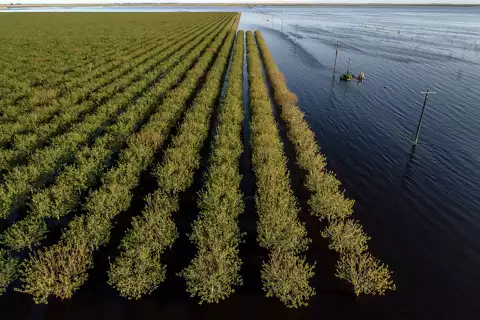In the heart of California’s San Joaquin Valley lies a remarkable tale of nature’s resilience and human ingenuity. Over 130 years ago, the largest body of water west of the Mississippi River, Tulare Lake, disappeared from the map, leaving behind a parched landscape. Now, against all odds, it’s making a comeback.
A Once-Vibrant Ecosystem Lost
Tulare Lake was once a thriving ecosystem, spanning over 570 square miles and supporting an abundance of wildlife and plant species. Fed by the Kings, Kaweah, Tule, and Kern Rivers, it was a vital source of water for the region, sustaining indigenous communities and attracting settlers to its fertile shores.
However, unsustainable water management practices, combined with a rapidly expanding agricultural industry, led to the demise of Tulare Lake. The construction of dams, levees, and canals diverted water away from the lake to irrigate farmland, drastically reducing its size and eventually draining it dry by the early 20th century.
Rebirth of Tulare Lake
Despite its disappearance from maps and memories, Tulare Lake never truly vanished. Beneath the surface, remnants of its former glory lingered, waiting for an opportunity to resurface. That opportunity came in the form of innovative water management strategies and a growing awareness of the need to restore California’s natural landscapes.
One of the key initiatives driving the revival of Tulare Lake is the Sustainable Groundwater Management Act (SGMA), passed in 2014. This landmark legislation aims to achieve sustainable groundwater management across California, ensuring the long-term viability of aquifers and surface water sources.
Through a combination of groundwater recharge projects, habitat restoration efforts, and collaborative conservation initiatives, stakeholders in the San Joaquin Valley are working to replenish Tulare Lake and revive the surrounding ecosystem. By capturing excess surface water during wet years and storing it underground, they are replenishing depleted aquifers and recharging the region’s natural water cycle.
A Beacon of Hope for the Future
The resurgence of Tulare Lake is more than just a testament to nature’s resilience; it’s a symbol of hope for the future of California’s water resources. In the face of climate change and growing water scarcity, restoring and preserving natural ecosystems like Tulare Lake is essential for ensuring the long-term sustainability of agriculture, communities, and biodiversity in the San Joaquin Valley and beyond.
The return of Tulare Lake also highlights the importance of collaborative stewardship and innovative solutions in addressing complex environmental challenges. By bringing together diverse stakeholders, including farmers, conservationists, policymakers, and indigenous communities, we can chart a course towards a more sustainable and resilient future.
As Tulare Lake once again becomes a thriving hub of biodiversity and a vital source of water for the region, it serves as a reminder of the profound interconnectedness of ecosystems and the profound impact of human actions on the natural world. By learning from the mistakes of the past and embracing a more holistic approach to water management, we can ensure that future generations inherit a world where majestic lakes like Tulare continue to flourish.
.






